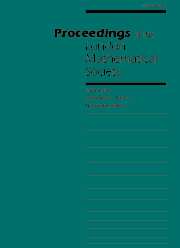Article contents
ESTIMATES OF BEST CONSTANTS FOR WEIGHTED POINCARÉ INEQUALITIES ON CONVEX DOMAINS
Published online by Cambridge University Press: 09 June 2006
Abstract
Let $1 \le q \le p <\infty$ and let $\mathcal{C}$ be the class of all bounded convex domains $\Omega$ in $\mathbb{R}^n$. Following the approach in `An optimal Poincaré inequality in $L^1$ for convex domains', by G. Acosta and R. G. Durán (Proc. Amer. Math. Soc. 132 (2003) 195–202), we show that the best constant $C$ in the weighted Poincaré inequality
$$ \| f - f_{av} \|_{L^q_w (\Omega)} \le C w(\Omega)^{\frac{1}{q} - \frac{1}{p}} \mbox{diam}(\Omega) \| \nabla f \|_{L^p_w(\Omega)} $$
for all $\Omega \in \mathcal{C}$, all Lipschitz continuous functions $f$ on $\Omega$, and all weights $w$ which are any positive power of a non-negative concave function on $\Omega$ is the same as the best constant for the corresponding one-dimensional situation, where $\mathcal{C}$ reduces to the class of bounded intervals. Using facts from `Sharp conditions for weighted 1-dimensional Poincaré inequalities', by S.-K. Chua and R. L. Wheeden (Indiana Math. J. 49 (2000) 143–175), we estimate the best constant. In the case $q = 1$ and $1 <\infty$, our estimate is between the best constant and twice the best constant. Furthermore, when $p = q = 1$ or $p = q = 2$, the estimate is sharp. Finally, in the case where the domains in $\mathbb{R}^n$ are further restricted to be parallelepipeds, we obtain a slightly different form of Poincaré's inequality which is better adapted to directional derivatives and the sidelengths of the parallelepipeds. We also show that this estimate is sharp for a fixed rectangle.
Keywords
- Type
- Research Article
- Information
- Copyright
- 2006 London Mathematical Society
- 24
- Cited by


